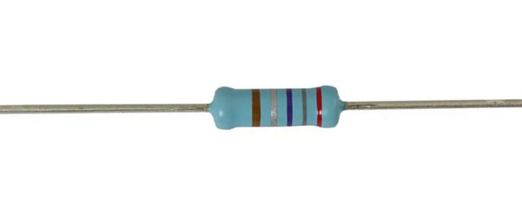Resistors with color bands are a convenient way for users to determine their resistance values without needing any measuring tools. These color-coded markings are commonly found on cylindrical resistors, such as carbon film, metal film, metal oxide film, fuse, and wire-wound resistors. Depending on the type, these resistors may have four, five, or six color bands that represent different aspects of their resistance value. Color-coded resistors are among the most frequently used components in electronic circuits. They use colored bands painted around the resistor body to indicate their resistance value. The basic units for resistance include ohms (Ω), kilo-ohms (KΩ), and mega-ohms (MΩ). For reference, 1 MΩ equals 1000 KΩ or 1,000,000 Ω. Most color-coded resistors fall into two main categories: four-band and five-band types, with the four-band being more widely used. In a four-band resistor, the first two bands represent the significant digits, the third band is the multiplier, and the fourth band shows the tolerance. For a five-band resistor, the first three bands are the significant digits, the fourth is the multiplier, and the fifth represents the tolerance. Common tolerance indicators include gold (5%), silver (10%), and brown (1%). If no color is present, it typically means a 20% tolerance, while green may occasionally be used for 0.5% tolerance. A four-band resistor uses four colored bands to indicate its resistance value. From left to right, the first band is the first digit, the second band is the second digit, the third band is the multiplier, and the fourth band indicates the tolerance. If you're unsure which band is the first one, look at the fourth band — it's usually gold or silver, as other colors rarely appear there. This method only works for four-band resistors and not for five-band ones. Examples: A five-band resistor has five colored bands that indicate its resistance value. The first three bands represent the significant digits, the fourth is the multiplier, and the fifth shows the tolerance. For example, if the bands are Red, Red, Black, Black, Brown, the calculation would be 220 × 1 = 220Ω, with a tolerance of 1%. Six-band resistors are less common but still used in high-precision applications. The first five bands work the same as in a five-band resistor, with the sixth band indicating the temperature coefficient. These resistors are typically found in specialized electronics where accuracy is critical. Understanding how to read resistor color codes is essential for anyone working with electronics. Whether you're building a circuit or troubleshooting a device, knowing the resistance value and tolerance can help ensure your design functions correctly. Always double-check the bands, especially when dealing with smaller resistors where the bands might be hard to see. Composite Hose,Composite Cryogenic Hose,Flexible Composite Hoses,Composite Chemical Hose Hebei no one but god energy equipment co.,ltd , https://www.p-harcourtbrothers.com

How to Identify Four-Band Resistors
How to Identify Five-Band Resistors
How to Identify Six-Band Resistors